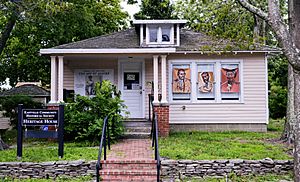St. David African Methodist Episcopal Zion Cemetery facts for kids
The St. David African Methodist Episcopal Zion Cemetery is a special historical place in the Eastville community. This area is part of the Sag Harbor National Historic District. The cemetery is connected to the AME church and the Eastville Historical Society House. About 100 people are buried here. This includes Reverend J. P. Thompson, who was the first pastor of the St. David AME Zion Church.
A Look Back: Early History of Eastville
The Eastville community started in the 1830s. This was when Sag Harbor was a busy whaling town. Many different people lived here. There were Irish, Native American, and African-American workers. The area was first called Snooksville. It was named after the Irish Snooks-Hicks family. Later, it became Eastville because it was east of the main village.
The AME church was built in 1839. African Americans and Native Americans built it. It is still in its original spot on Eastville Avenue. People believe it was a stop on the Underground Railroad. This was a secret network that helped enslaved people find freedom. The church's founder, Rev. J. P. Thompson, was an abolitionist. This means he worked to end slavery. He was also a close friend of the famous speaker Frederick Douglass.
The Eastville Community Historical Society of Sag Harbor was started in 1981. This group takes care of the old cemetery next to the church. Many African and Native Americans from the St. David's church are buried there. A lot of them were whalers from Sag Harbor. Many Quakers also lived in the community. They were also against slavery.
In 1857, the church trustees bought the land for the cemetery. They were Elymus Derby, Samuel Butler, and David Hempstead. They bought it from Hannah and Anna Maria Solomon. People continued to be buried there until 1993.
Exploring the Past: Archeology at the Cemetery
From the early 1800s to the mid-1900s, Eastville was a home for many different groups. Free Black people, European immigrants, and Native Americans lived here. The area changed a lot over time. There were two big fires in the village. The whaling industry grew, then it declined. Factories were built, and now tourism is very popular.
Today, Eastville still has many different kinds of people. Some African-American families have moved away. New homes are being built. These new, very large houses are changing the look of the area. They are different from the smaller summer cottages built in the 1950s.
In 2014, a historic marker was placed at the cemetery. Students from the University of Minnesota helped survey the cemetery. They used special radar that looks into the ground. This helped them map the burial sites. The Eastville Community Historical Society (ECHS) received money for this work. The Archaeological Institute of America (AIA) gave them a grant in 2013. The ECHS used this money to help protect the AME Cemetery. This site shows the history of working-class African American, Irish immigrant, and Native American people from the 1800s and early 1900s. The William G. Pomeroy Foundation, the Huntington Arts Council, and the Archaeological Institute of America also helped pay for the historic marker.
The Heritage House: A Center for History
The Heritage House was built in 1925. It was originally bought from a Sears & Roebuck catalog. In 1996, it became the main office for the Eastville Community Historical Society. It is located at 139 Hampton Street. Today, the society manages the AME Cemetery from here.
Since 1985, the society has worked hard to preserve the Eastville community. They also helped get the nearby Sag Harbor Hills, Azurest, and Ninevah Beach Subdivisions Historic District recognized. The National Park Service gave it this special title.



